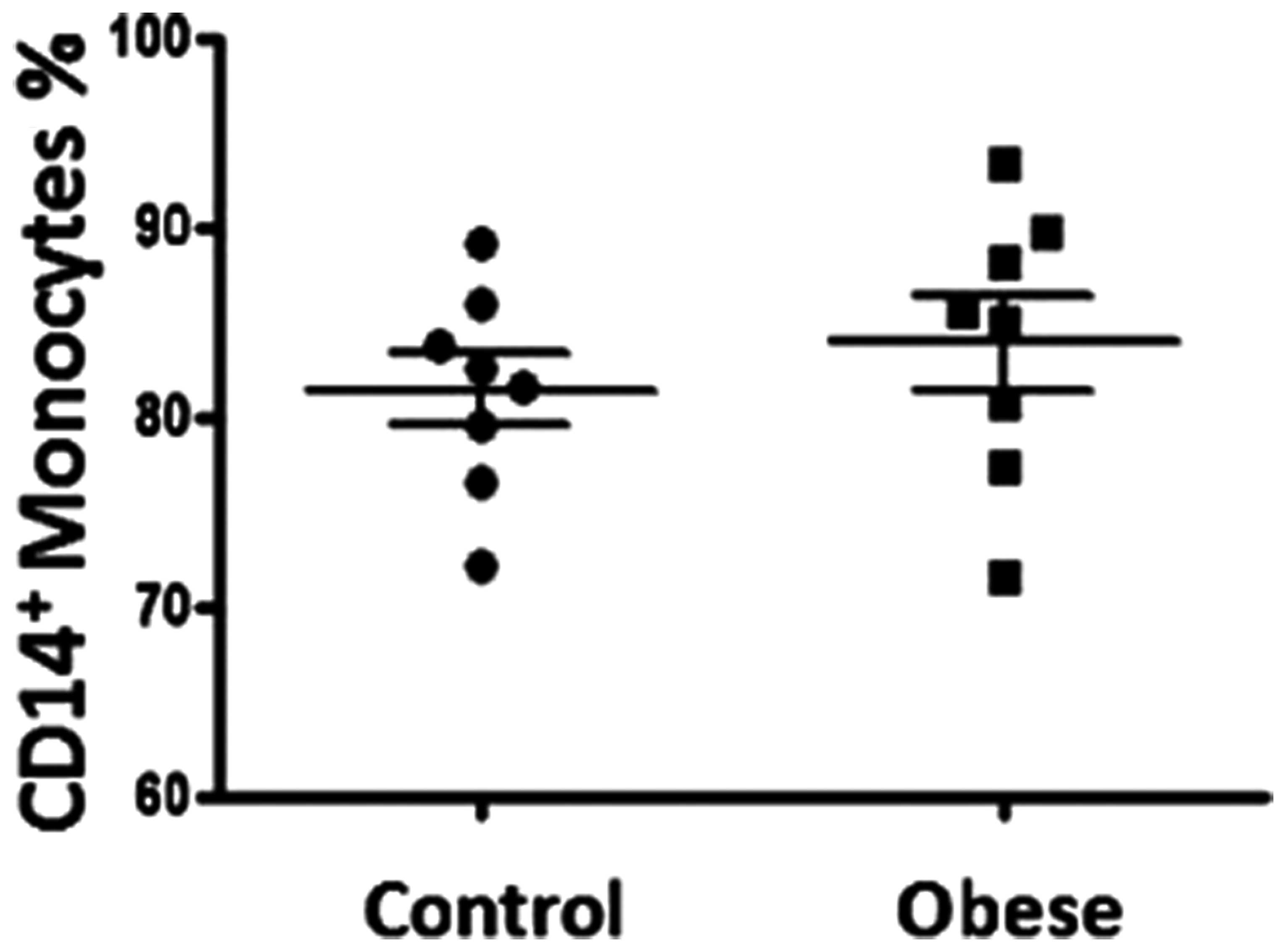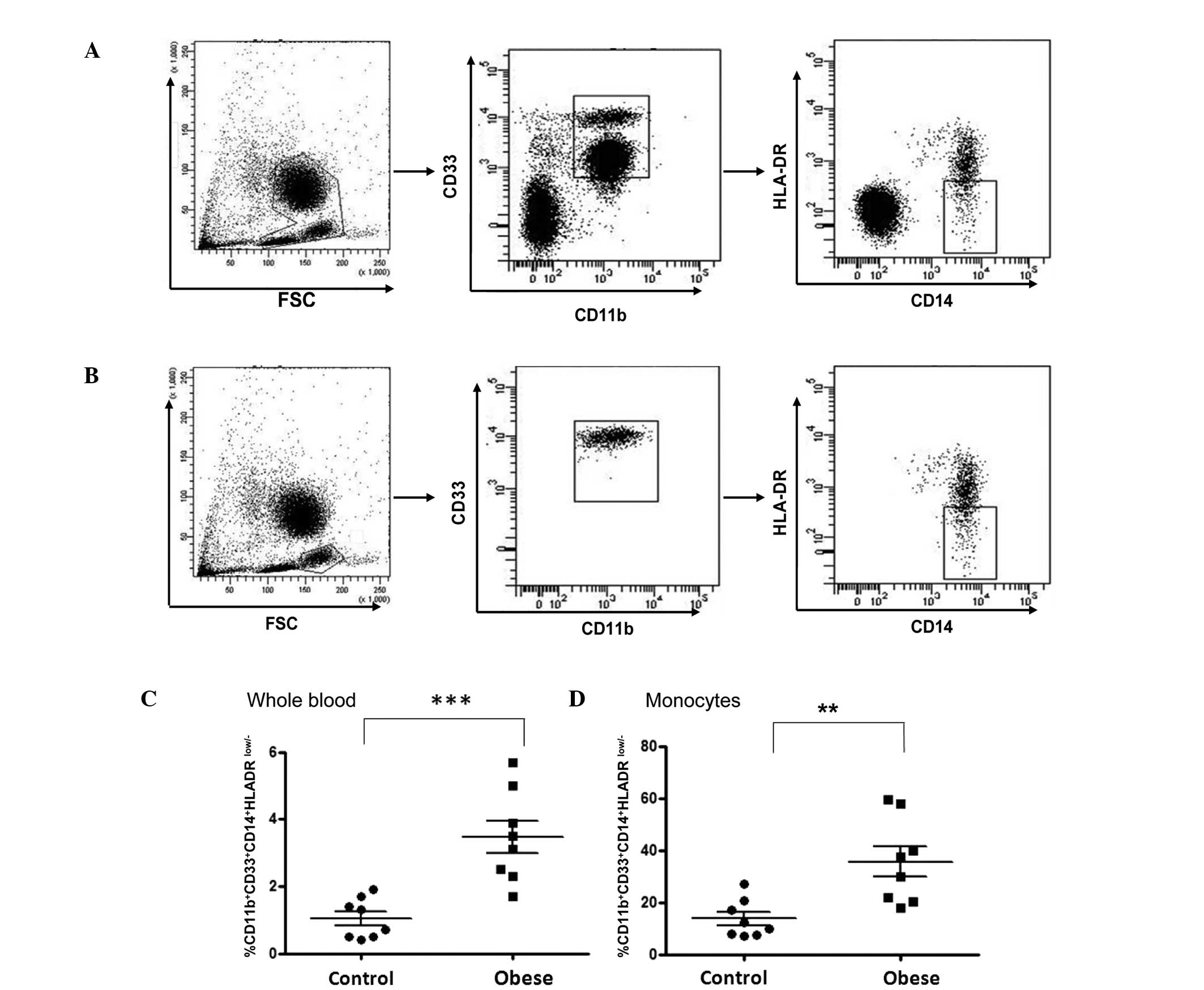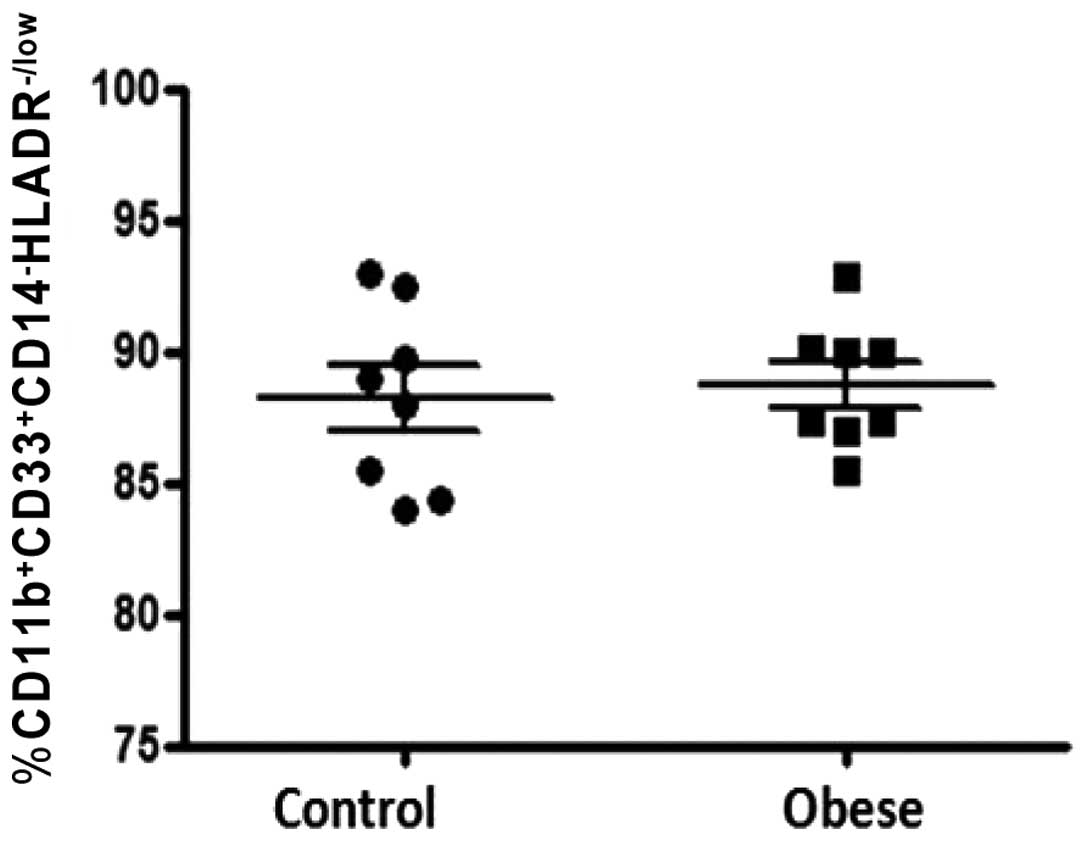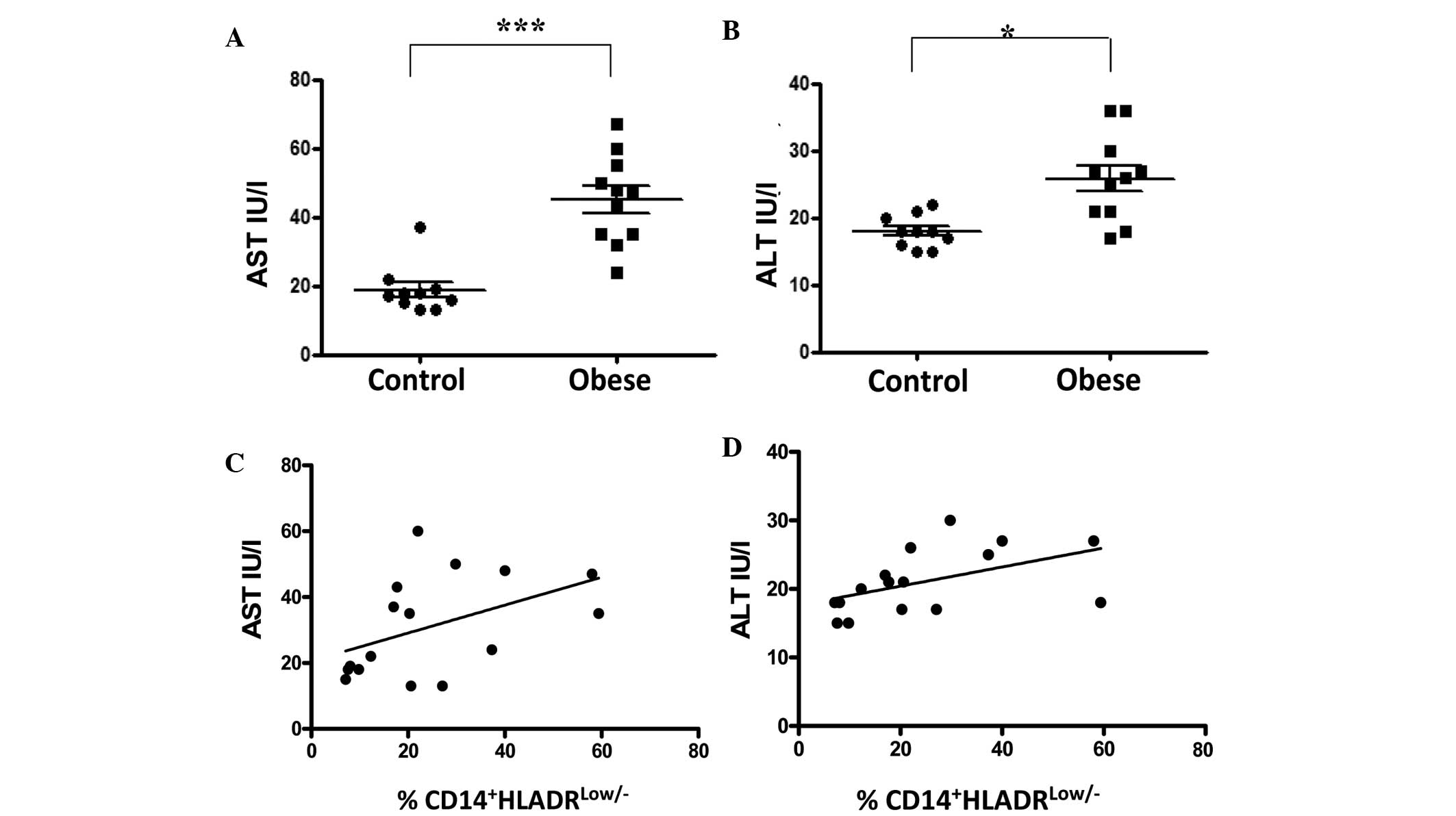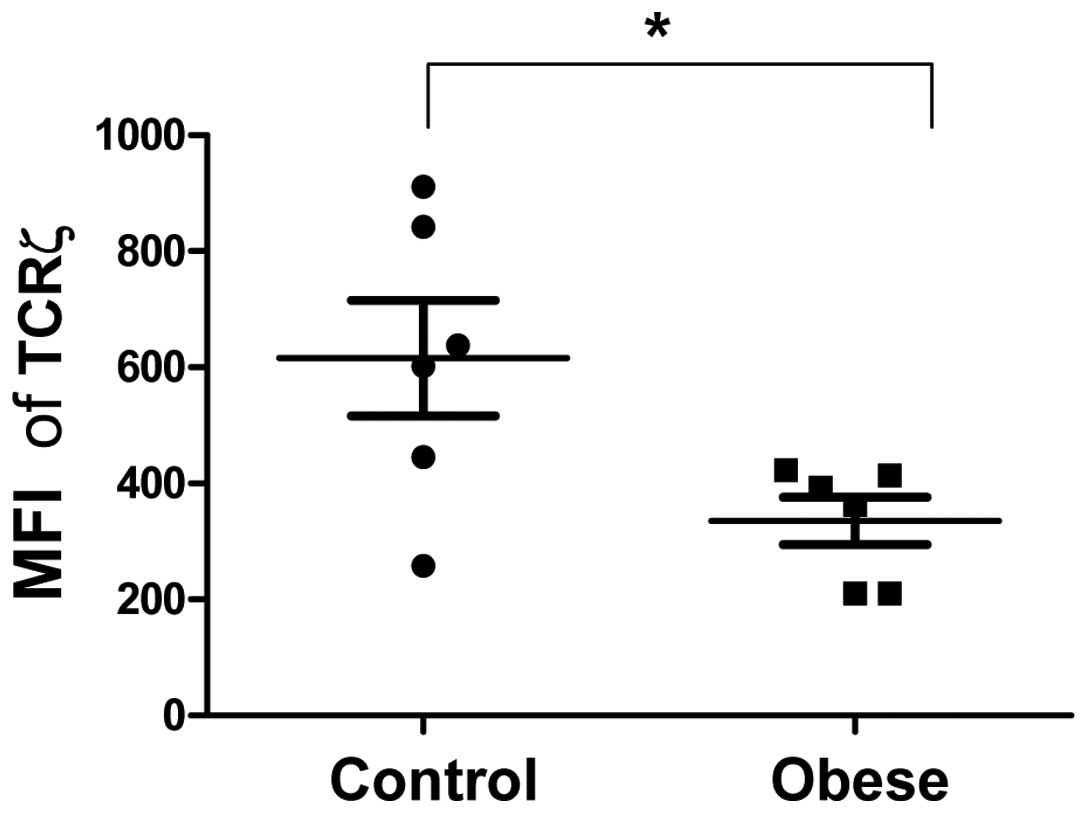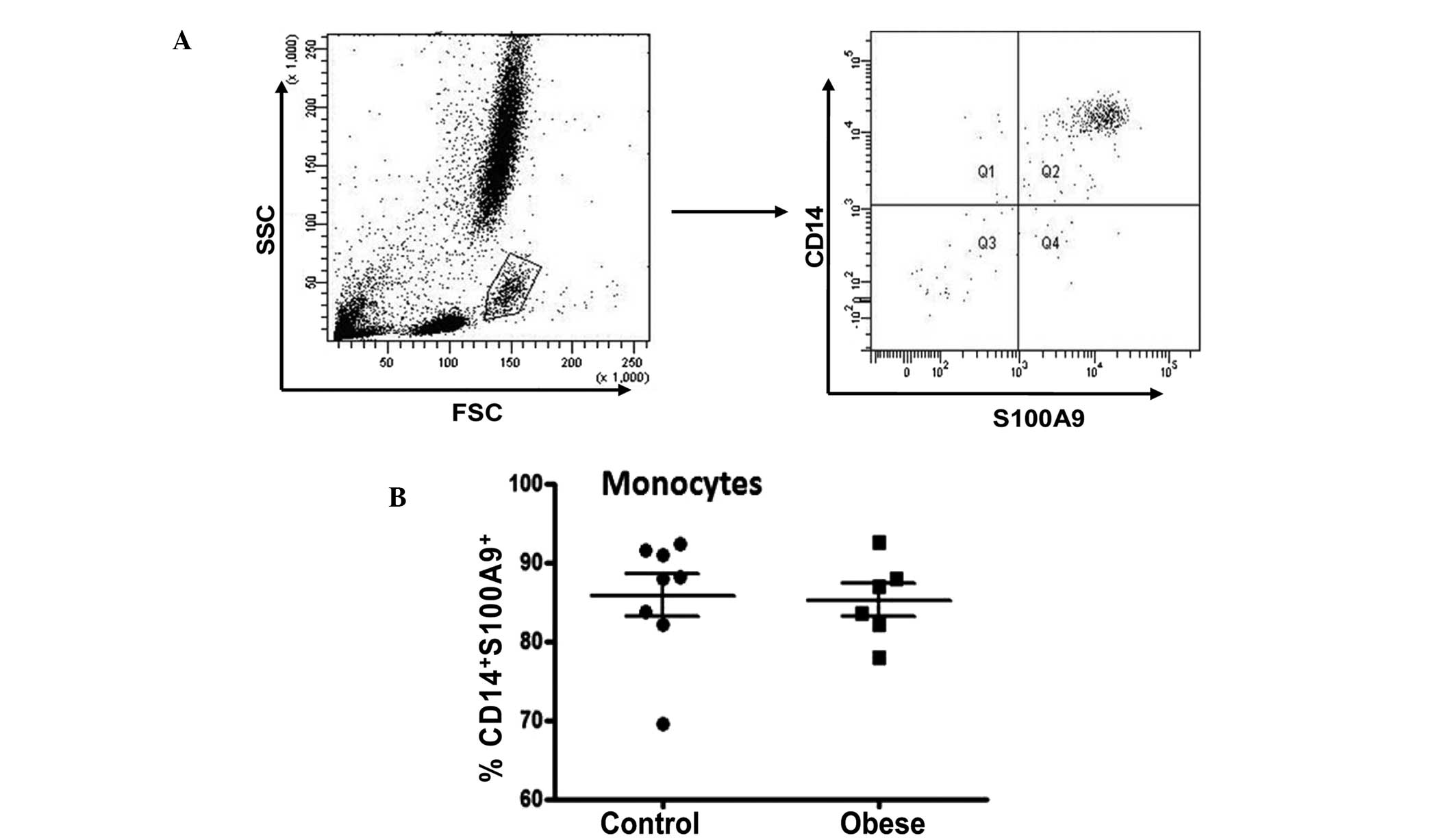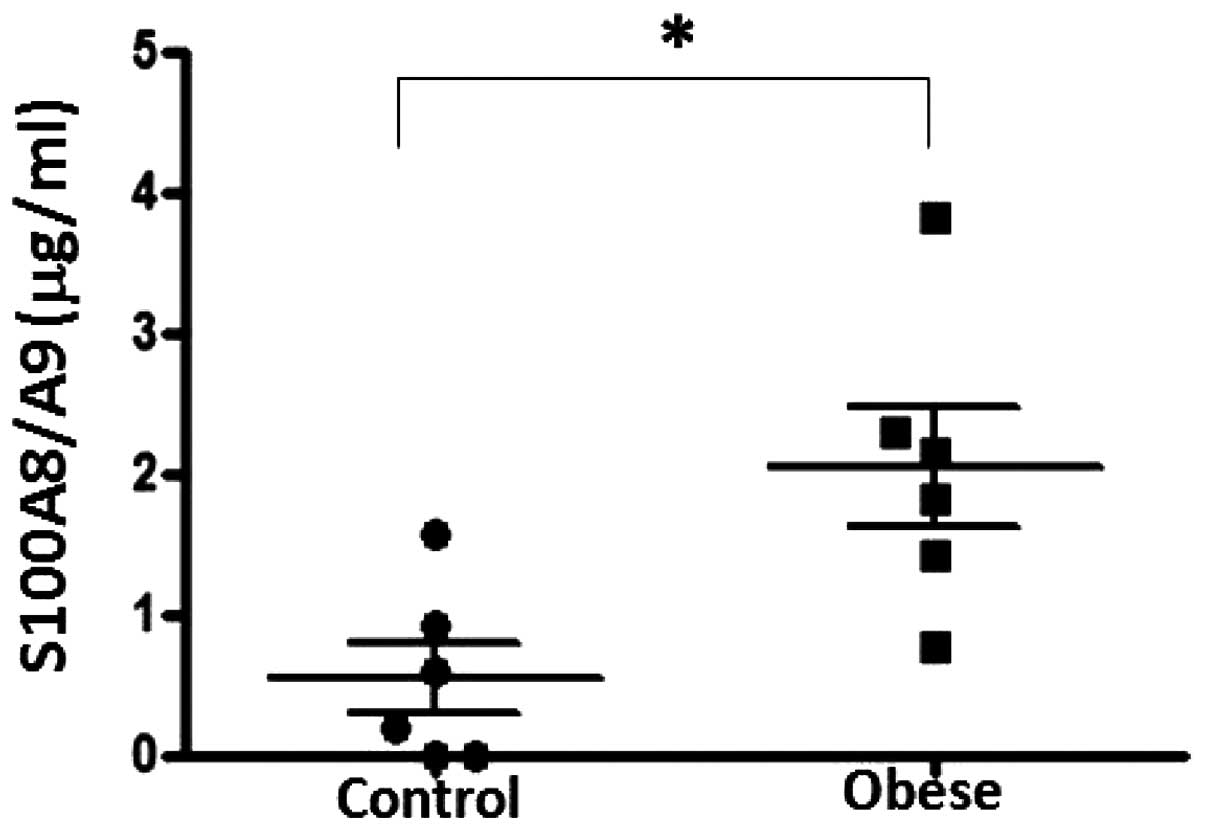Increased monocytic CD14+HLADRlow/- myeloid-derived suppressor cells in obesity
- Authors:
- Published online on: November 11, 2014 https://doi.org/10.3892/mmr.2014.2927
- Pages: 2322-2328
Abstract
Introduction
Obesity may be regarded as a low-level chronic inflammatory state, and is associated with type 2 diabetes mellitus, cardiovascular disease and a number of cancer types, such as breast cancer, colorectal cancer and prostate cancer (1,2).
Adipose tissue is viewed as an endocrine organ, which produces a wide range of pro-inflammatory cytokines, such as monocyte chemoattractant protein-1 (MCP-1), interlukin-6 (IL-6) and tumor necrosis factor-α (TNF-α). These molecules are collectively termed adipokines (3). Immunological dysregulation in obese subjects may result from interactions between white adipose tissue and the immune system (4). Obesity affects macrophage accumulation in fat stores, as well as T cell-mediated responses (5). Evidence has arisen suggesting that a reduction in levels of circulating T regulatory cells (Tregs) has an impact on the increased risk of metabolic and cardiovascular dysfunctions observed in obese patients (6). Myeloid-derived suppressor cells (MDSCs) are a population of myeloid cells, which act to suppress the proliferation and function of effector T cells (7) via alteration of the signal-transducing molecule, TCRζ, on the surface of T cells (8). Decreased TCRζ chain expression in circulating T cells has been reported in a number of types of cancer, including melanoma, and ovarian, breast, renal and oral squamous cell carcinoma, and is associated with a compromised antitumor response as a result of reduced T cell proliferation and cytokine production (9,10). MDSCs have been investigated in numerous types of cancer. However, there have been few studies into the phenotype and functions of these cells in obese patients.
The S100A8 and S100A9 proteins have been identified as members of the S100 Ca2+-binding protein family, and are known to form a heterodimeric complex, S100A8/A9, which is involved in mediating the inflammatory response (11). Recently, it has been suggested that S100A8/A9 proteins may serve as a novel marker for monocytic MDSCs (12). However, whether S100A8/A9 proteins are also elevated in obese subjects, and thus affect the frequency of monocytic MDSCs in these individuals, requires further investigation.
The present study characterized the proportion and phenotypes of MDSCs in the circulation of obese subjects compared with those in lean subjects and examined whether MDSCs correlate with levels of liver enzymes. In addition, the levels of S100A9/9 were measured and the proportion of CD14+S100A9+ cells in obese and lean subjects was examined.
Materials and methods
Subject recruitment and blood sample preparation
A total of 16 adult Chinese men, including eight overweight/obese subjects (BMI >25 kg/m2) and eight lean healthy controls (BMI <25 kg/m2) were recruited between February and June 2013. Subjects with type 2 diabetes mellitus, hepatitis or other medical comorbidities likely to impact on the immune system were excluded. The clinical information from the two groups is summarized in Table I. The study was approved by the Medical Ethical Committee of the Second Hospital of Jiaxing, (Jiaxing, China). Blood samples were collected from all study subjects using vacuette sodium heparin-containing tubes (BD Biosciences, Franklin Lakes, NJ, USA) and further processed within 24 h of collection. Plasma was isolated by centrifugation at 1000 × g for 10 min and stored at −20°C for further analyses. Liver serum parameters, alanine transaminase (ALT) and aspartate transaminase (AST), were determined by an automated chemistry analyzer (D2400/P800; Roche Diagnostics, Basel, Switzerland).
Ultrasonography
Ultrasonography was performing using a B-mode of Ultrasound (iU22 xMATRIX, Philips Healthcare, Andover, MA, USA). Screening for fatty liver was based on a B ultrasonic diagnosis according to the standard guidelines of the Chinese Medical Association (13).
Flow cytometric analysis
To determine the proportion and phenotypes of MDSCs in total plasma leukocytes, multicolor fluorescence-activated cell sorting (FACS) analysis was conducted using freshly-collected whole blood and fluorochrome-conjugated mouse anti-human monoclonal antibodies against CD11b, CD14, CD16, CD15, CD33 and HLADR, as well as isotype control antibodies (BD Pharmingen, San Diego, CA, USA). S100A9 was obtained from BioLegend Inc. (San Diego, CA, USA) and staining was performed according to the manufacturer’s instructions. Intracellular staining of TCRζ (BD Pharmingen) was conducted using the methods described previously (14). In this experiment, peripheral blood mononulcear cells (PBMCs) were isolated from 4 ml whole blood. Blood in a vacuette tube was transferred to a 15 ml conical tube (BD Falcon, Franklin Lakes, NJ), diluted to a volume of 8 ml with 1 × PBS (Solarbio, Beijing, P.R. China), and underlayed with 4 ml of Ficoll Paque (Sigma-Aldrich, St. Louis, MO, USA). The PBMCs were collected at the interface layer following centrifugation of the conical tube at 400 × g for 30 min. Data were collected using a BD FACSCanto II flow cytometer, and analyzed with DIVA software (version V6.1.3, BD Pharmingen).
ELISA assay
Plasma was obtained from obese and lean subjects, and stored at −20°C. The plasma concentration of S100A8/9 was measured using a commercially available ELISA kit, according to the manufacturer’s instructions (Cuisabio Biotech Co., Ltd., Wuhan, China).
Statistical analysis
Data are presented as the mean ± standard error of the mean. Differences in means between groups of data were analyzed using Student’s unpaired t-test. Correlation analysis was performed using Pearson’s correlation with the coefficient of correlation (r2). Statistical analysis was performed, and figures created, using Prism Version 5.0 software (GraphPad Software Inc., La Jolla, CA, USA). P<0.05 was considered to indicate a statistically significant difference.
Results
CD14+ monocyte numbers in the peripheral blood of obese subjects
The total number of monocytes in the peripheral blood in each group was analyzed. The absolute number of monocytes in peripheral blood was not significantly different in obese individuals compared with lean controls (P>0.05; Table I). The percentage of CD14+ monocytes was further analyzed in whole blood by flow cytometry. No significant difference was observed between the obese and lean groups (83.91±2.490 compared with 81.36±1.893%, respectively; P>0.05; Fig. 1).
Phenotypical characterization of myeloid-derived suppressor cells in obese subjects
To determine whether the proportion of granulocytic and monocytic MDSCs, two previously identified subtypes of MDSCs (15), was increased in obese subjects, these two populations were analyzed using flow cytometric analysis. MDSCs have been defined as a heterogeneous cell population with a granulocytic phenotype CD33+CD11b+CD14−HLADR− in renal cell carcinoma, glioblastoma and gastric cancer (16–18). In addition, monocytic MDSCs, with a phenotype of CD14+CD11b+HLADRlow/−, have also been described in circulating leukocytes of patients with melanoma (19). In the present study, granulocytic MDSCs were defined as those expressing CD33 and CD11b, but that were CD14−, with low/− HLADR. Monocytic MDSCs have alternatively been described as a population of cells with a typical CD33+CD11b+CD14+HLADRlow/− phenotype. The gating strategy used is shown in Fig. 2. Cells were gated on the whole blood cell fraction (Fig. 2A) as well as the monocytic fraction only (Fig. 2B). The percentage of monocytic MDSCs was significantly increased in the obese group compared with that in the age-matched lean control group when gated on the whole cell fraction (3.46±0.48 compared with 1.05±0.21%, respectively; P<0.001; Fig. 2C) as well as when gated on the monocytic fraction only (35.56±5.77 compared with 13.69±2.57, respectively; P<0.01; Fig. 2D). However, there was no significant difference in the percentage of CD33+CD11b+CD14−HLADRlow/− between obese and lean control groups when gated on whole blood cell fraction (88.71±0.84 compared with 88.19±1.25%, respectively; P>0.05; Fig. 3).
Serum levels of liver enzymes are correlated with the proportion of CD14+HLADRlow/− cells in obese subjects
Elevated serum levels of ALT and AST are markers of liver injury. In the present study, it was observed that the overweight obese individuals had elevated circulating levels of ALT compared with lean control subjects (23.88±1.49 vs. 18.25±0.92 IU/l, respectively; P<0.05; Fig. 4A). Levels of AST were also significantly higher in the obese group than in the lean group (42.75±3.94 compared with 19.38±2.75 IU/l, respectively; P<0.0001; Fig. 4B). The association between serum levels of ALT and AST and the proportion of CD14+HLADRlow/− monocytes in peripheral blood was examined. A positive correlation was observed between AST and CD14+HLADRlow/− monocytes (r=0.50, 95% CI −0.009 to 0.803; P<0.05; Fig. 4C); as well as between ALT and CD14+HLADRlow/− monocytes (r=0.58, 95% CI 0.102 to 0.840; P<0.05; Fig. 4D).
Expression of TCRζ is decreased in the PBMCs of obese subjects
To evaluate the expression of TCRζ in the peripheral T cell population, flow cytometric analysis was performed to measure TCRζ mean fluorescence intensity (MFI) in the CD3+ resting T cell population. The expression of TCRζ was reduced in obese subjects compared with lean controls (335.35±40.57 compared with 616±99.36 MFI, respectively; P=0.0259; Fig. 5)
Expression of S100A9 in CD14+ monocytes
The pro-inflammatory heterodimeric S100A8/9 complex is elevated in a number of chronic inflammatory diseases, including rheumatoid arthritis, cystic fibrosis and inflammatory bowel disease (20,21). S100A9 has been proposed as a novel marker for monocytic human MDSCs in certain types of malignancy (12). To investigate whether S100A9 serves as a marker for monocytic MDSCs in obesity, S100A9-specific antibodies were used to detect this intracellular molecule. As shown in Fig. 6A, cells were gated on the monocytic fraction following flow cytometry using whole peripheral blood. The majority of CD14+ monocytes were S100A9+ (Fig. 6A), and there was no difference in the proportion of CD14+S100A9+ between obese subjects and lean controls (85.20±2.07 compared with 85.80±2.67%, respectively; P>0.05; Fig. 6B). No statistically significant correlation was identified between CD14+HLADRlow/− MDSC and CD14+S100A9+ cells in the monocyte population (data not shown). In monocytes, a small population with a CD16+CD14− phenotype has previously been identified (22). The current study found that S100A9 was present in CD14+ cells but not in CD16+ cells (data not shown).
Plasma levels of S100A8/A9 in obese subjects
The plasma levels of S100A8/A9 were significantly increased in obese subjects compared with age-matched lean controls (2.04±0.423 compared with 0.548±0.252 μg/ml, respectively; P<0.05; Fig. 7).
Discussion
Monocytes respond to immune-stimulating cytokines (23). These are derived from pluripotent hematopoietic stem cells in the bone marrow, and can rapidly and efficiently differentiate into dendritic cells (23). The impaired immune response observed in obesity may be associated with the accumulation of macrophages in adipose tissue as a result of the attraction of monocytes from the circulation (23). The present study reports that an increased frequency of monocytic MDSCs appears to be amongst the immunosuppressive responses promoted by obesity.
The current study reports an increased population of CD14+HLADRlow/−-monocytes in obese subjects compared with lean subjects. CD14+HLADRlow/− monocytic MDSCs have been documented in patients with melanoma (19), and Non-Hodgkin lymphoma (NHL) (24). The increased proportion of CD14+HLADRlow/− monocytes leads to immunosuppression by impairing T cell functions, including inhibiting T cell proliferation, reducing their response to stimuli and reducing production of interferon γ (24).
Decreased monocyte expression of HLADR has been observed in a range of malignancies, such as hepatocellular carcinoma, prostate cancer and glioblastoma (25). In addition to tumors, an increased frequency of CD14+HLADRlow/− cells has also been reported in non-malignant conditions, such as sepsis (26), pancreatitis (27) and acute liver failure (28). Furthermore, a low percentage of monocytic HLADR expression serves as a predictor of poor clinical outcome in acute liver failure (29).
White adipose tissue is now regarded as a key endocrine organ, secreting a wide range of adipokines including leptin, adiponectin, TNF-α and IL-6. These molecules act locally or distantly to regulate energy balance and other physiological processes, such as insulin sensitivity and inflammatory responses (30,31). Pro-inflammatory cytokines may contribute to the loss of HLADR expression in monocytes in obese subjects. Obesity is associated with a spectrum of liver abnormalities and is known to cause nonalcoholic fatty liver disease (NAFLD) (32). In addition to regulating energy balance, the liver is also involved in mediating the immune response. Although no liver biopsies were performed in the current study, ultrasound examination indicated fatty livers in all obese subjects. In the present study, a significant positive correlation was observed between the proportion of CD14+HLADRlow/− monocytes and levels of the liver enzymes, AST and ALT. This data led to the hypothesis that the induction of these immunosuppressive monocytes may contribute to liver dysfunction in obesity. Recently, data has shown that human activated hepatic stellate cells are able to convert mature peripheral blood monocytes into MDSCs, and that this action may prevent ensuing liver injury (33). Therefore, further studies are required to investigate whether the elevated number CD14+HLADRlow/− monocytes originates from the injured liver or from the circulation. Furthermore, the question of how those immunosuppressive cells interact with hepatocytes in NAFLD should also be addressed.
MDSCs have been reported to suppress autologous T cell proliferation and reduce the expression of TCRζ on the surfaces of CD8+ cells. The ζ chain of TCR is a key component responsible for the initiation of immune responses mediated by T cells and natural killer cells (34). Reduced TCRζ expression in circulating lymphocytes has been reported in patients with ovarian cancer, breast cancer, oral cancer and melanoma (35). The reduced expression of TCRζ molecule in obese subjects indicates that CD14+HLADRlow/− monocytes may lead to immunosuppression via regulation of TCRζ expression. The upregulation of CD14+HLADRlow/− and downregulation of T cell function may be associated with the increased incidence of cancer in obese patients.
S100A8/9 is produced by myeloid and tumor cells (34), and elevated S100A8/9 can in turn induce the production of MDSCs in patients with cancer (36). Circulating levels of S100A8/9 have been shown to be upregulated in a number of tumor types, including gastric cancer (18). Blocking S1008/9 and its receptor, RAGE, on the surface of MDSCs may restore T cell proliferation (18). Recently, S100A9 has been proposed to be a novel marker for monocytic MDSCs in colon cancer (12). In the present study, S100A9 was found to be highly expressed in the majority of CD14+ monocytes and no association was found between CD14+S100A9+ and CD14+HLADRlow/− cells. Thus, whether S100A9 should be used as a marker for monocytic MDSCs requires further clarification. The elevation of S100A8/9 in the plasma of obese subjects may further induce the production of monocytic MDSCs in obesity.
In conclusion, to the best of our knowledge, the current study reports for the first time that the proportion of an immunosuppressive monocytic population with a CD14+HLADRlow/− phenotype is significantly elevated in the circulation of obese subjects compared with that of lean control subjects. The increased frequency of this cell population is positively correlated with the concentration of liver enzymes in the plasma. The expression of the TCRζ molecule was found to be downregulated in obese patients. In addition CD14+HLADRlow/− monocytes are not correlated with CD14+S100A9+ expression. The plasma concentration of S100A8/9 was found to be increased in obesity. These findings suggest that the upregulation of CD14+HLADRlow/− may be responsible for the impaired T-cell function and liver injury observed in obesity.
Acknowledgements
The authors would like to thank Dr Bing Chen (University of Liverpool, Liverpool, UK) for her revisions to the manuscript. This study was supported by grants from the Chinese National Science Fund for Young Scholars (grant no. 81101707), the Zhejiang Traditional Chinese Medicine Foundation Project (grant no. 2011ZA104) and the Science and Technology Bureau of Jiaxing (grant no. 2012AY1071-2).
References
|
Renehan AG, Tyson M, Egger M, Heller RF and Zwahlen M: Body-mass index and incidence of cancer: a systematic review and meta-analysis of prospective observational studies. Lancet. 371:569–578. 2008. View Article : Google Scholar : PubMed/NCBI | |
|
Rader DJ: Effect of insulin resistance, dyslipidemia, and intra-abdominal adiposity on the development of cardiovascular disease and diabetes mellitus. Am J Med. 120(Suppl 1): S12–S18. 2007. View Article : Google Scholar : PubMed/NCBI | |
|
de Leal VO and Mafra D: Adipokines in obesity. Clin Chim Acta. 419:87–94. 2013. View Article : Google Scholar | |
|
van der Weerd K, Dik WA, Schrijver B, et al: Morbidly obese human subjects have increased peripheral blood CD4+ T cells with skewing toward a Treg- and Th2-dominated phenotype. Diabetes. 61:401–408. 2012. View Article : Google Scholar : PubMed/NCBI | |
|
de Heredia FP, Gómez-Martinez S and Marcos A: Obesity, inflammation and the immune system. Proc Nutr Soc. 71:332–338. 2012. View Article : Google Scholar : PubMed/NCBI | |
|
Wagner NM, Brandhorst G, Czepluch F, et al: Circulating regulatory T cells are reduced in obesity and may identify subjects at increased metabolic and cardiovascular risk. Obesity (Silver Spring). 21:461–468. 2013. View Article : Google Scholar | |
|
Lindau D, Gielen P, Kroesen M, Wesseling P and Adema GJ: The immunosuppressive tumour network: myeloid-derived suppressor cells, regulatory T cells and natural killer T cells. Immunology. 138:105–115. 2013. View Article : Google Scholar : | |
|
Umansky V and Sevko A: Overcoming immunosuppression in the melanoma microenvironment induced by chronic inflammation. Cancer Immunol Immunother. 61:275–282. 2012. View Article : Google Scholar | |
|
Irving BA, Chan AC and Weiss A: Functional characterization of a signal transducing motif present in the T cell antigen receptor zeta chain. J Exp Med. 177:1093–1103. 1993. View Article : Google Scholar : PubMed/NCBI | |
|
Irving BA and Weiss A: The cytoplasmic domain of the T cell receptor zeta chain is sufficient to couple to receptor-associated signal transduction pathways. Cell. 64:891–901. 1991. View Article : Google Scholar : PubMed/NCBI | |
|
Srivastava MK, Andersson Å, Zhu L, et al: Myeloid suppressor cells and immune modulation in lung cancer. Immunotherapy. 4:291–304. 2012. View Article : Google Scholar : PubMed/NCBI | |
|
Zhao F, Hoechst B, Duffy A, et al: S100A9 a new marker for monocytic human myeloid-derived suppressor cells. Immunology. 136:176–183. 2012. View Article : Google Scholar : PubMed/NCBI | |
|
Schouppe E, Van Overmeire E, Laoui D, et al: Modulation of CD8(+) T-cell activation events by monocytic and granulocytic myeloid-derived suppressor cells. Immunobiology. 218:1385–1391. 2013. View Article : Google Scholar : PubMed/NCBI | |
|
Kono K, Ressing ME, Brandt RM, et al: Decreased expression of signal-transducing zeta chain in peripheral T cells and natural killer cells in patients with cervical cancer. Clin Cancer Res. 2:1825–1828. 1996.PubMed/NCBI | |
|
Fatty Liver and Alcoholic Liver Disease Study Group of Chinese Liver Disease Association. Diagnostic criteria of nonalcoholic fatty liver disease. Zhoonghua Gan Zang Bing Za Zhi. 11:712003.(In Chinese). | |
|
Kusmartsev S, Su Z, Heiser A, et al: Reversal of myeloid cell-mediated immunosuppression in patients with metastatic renal cell carcinoma. Clin Cancer Res. 14:8270–8278. 2008. View Article : Google Scholar : PubMed/NCBI | |
|
Ozao-Choy J, Ma G, Kao J, et al: The novel role of tyrosine kinase inhibitor in the reversal of immune suppression and modulation of tumor microenvironment for immune-based cancer therapies. Cancer Res. 69:2514–2522. 2009. View Article : Google Scholar : PubMed/NCBI | |
|
Wang L, Chang EW, Wong SC, et al: Increased myeloid-derived suppressor cells in gastric cancer correlate with cancer stage and plasma S100A8/A9 proinflammatory proteins. J Immunol. 190:794–804. 2013. View Article : Google Scholar | |
|
Filipazzi P, Valenti R, Huber V, et al: Identification of a new subset of myeloid suppressor cells in peripheral blood of melanoma patients with modulation by a granulocyte-macrophage colony-stimulation factor-based antitumor vaccine. J Clin Oncol. 25:2546–2553. 2007. View Article : Google Scholar : PubMed/NCBI | |
|
Gebhardt C, Németh J, Angel P and Hess J: S100A8 and S100A9 in inflammation and cancer. Biochem Pharmacol. 72:1622–1631. 2006. View Article : Google Scholar : PubMed/NCBI | |
|
Foell D, Wittkowski H, Ren Z, et al: Phagocyte-specific S100 proteins are released from affected mucosa and promote immune responses during inflammatory bowel disease. J Pathol. 216:183–192. 2008. View Article : Google Scholar : PubMed/NCBI | |
|
Auffray C, Sieweke MH and Geissmann F: Blood monocytes: development, heterogeneity, and relationship with dendritic cells. Annu Rev Immunol. 27:669–692. 2009. View Article : Google Scholar : PubMed/NCBI | |
|
Hansmann L, Groeger S, von Wulffen W, Bein G and Hackstein H: Human monocytes represent a competitive source of interferon-alpha in peripheral blood. Clin Immunol. 127:252–264. 2008. View Article : Google Scholar : PubMed/NCBI | |
|
Lin Y, Gustafson MP, Bulur PA, et al: Immunosuppressive CD14+HLA-DR(low)/− monocytes in B-cell non-Hodgkin lymphoma. Blood. 117:872–881. 2011. View Article : Google Scholar : | |
|
Najjar YG and Finke JH: Clinical perspectives on targeting of myeloid derived suppressor cells in the treatment of cancer. Front Oncol. 3:492013. View Article : Google Scholar : PubMed/NCBI | |
|
Monneret G, Lepape A, Voirin N, et al: Persisting low monocyte human leukocyte antigen-DR expression predicts mortality in septic shock. Intensive Care Med. 32:1175–1183. 2006. View Article : Google Scholar : PubMed/NCBI | |
|
Mentula P, Kylänpää-Bäck ML, Kemppainen E, et al: Decreased HLA (human leucocyte antigen)-DR expression on peripheral blood monocytes predicts the development of organ failure in patients with acute pancreatitis. Clin Sci (Lond). 105:409–417. 2003. View Article : Google Scholar | |
|
Antoniades CG, Berry PA, Davies ET, et al: Reduced monocyte HLA-DR expression: a novel biomarker of disease severity and outcome in acetaminophen-induced acute liver failure. Hepatology. 44:34–43. 2006. View Article : Google Scholar : PubMed/NCBI | |
|
Zimmermann HW, Trautwein C and Tacke F: Functional role of monocytes and macrophages for the inflammatory response in acute liver injury. Front Physiol. 3:562012. View Article : Google Scholar : PubMed/NCBI | |
|
Trayhurn P and Wood IS: Adipokines: inflammation and the pleiotropic role of white adipose tissue. Br J Nutr. 92:347–355. 2004. View Article : Google Scholar : PubMed/NCBI | |
|
Trayhurn P, Bing C and Wood IS: Adipose tissue and adipokines - energy regulation from the human perspective. J Nutr. 136(Suppl 7): 1935S–1939S. 2006. | |
|
Rahimi RS and Landaverde C: Nonalcoholic fatty liver disease and the metabolic syndrome: clinical implications and treatment. Nutr Clin Pract. 28:40–51. 2013. View Article : Google Scholar : PubMed/NCBI | |
|
Höchst B, Schildberg FA, Sauerborn P, et al: Activated human hepatic stellate cells induce myeloid derived suppressor cells from peripheral blood monocytes in a CD44-dependent fashion. J Hepatol. 59:528–535. 2013. View Article : Google Scholar : PubMed/NCBI | |
|
Baniyash M: TCR zeta-chain downregulation: curtailing an excessive inflammatory immune response. Nat Rev Immunol. 4:675–687. 2004. View Article : Google Scholar : PubMed/NCBI | |
|
Whiteside TL: Down-regulation of zeta-chain expression in T cells: a biomarker of prognosis in cancer? Cancer Immunol Immunother. 53:865–878. 2004.PubMed/NCBI | |
|
Sinha P, Okoro C, Foell D, et al: Proinflammatory S100 proteins regulate the accumulation of myeloid-derived suppressor cells. J Immunol. 181:4666–4675. 2008. View Article : Google Scholar : PubMed/NCBI |



